Overview
Cloud costs are no longer just for IT finance analysts—cost management is a core part across IT operations. VMware Cloud Foundation (VCF) brings together private cloud infrastructure with FinOps principles to help ensure financial accountability, operational visibility, and business alignment for all IT users. The FinOps framework in VCF enables enterprises to not only provision infrastructure but also optimize, govern, and allocate costs intelligently across developers and providers.

In an era where IT infrastructure costs are rapidly escalating, particularly with the rise of AI initiatives, enterprise organizations demand greater control and visibility over their expenditures. This necessitates not only refined service metering and billing, but also the ability to accurately capture and view the Total Cost of Ownership (TCO) and overall expenses. Concurrently, IT teams face the challenge of optimizing infrastructure to reduce costs and promote resource reuse, while also refining service metering and billing for a diverse array of modern services, including VMs, AI services, database services, Kubernetes services, and storage services.
Cost Management
VCF cost management monitors and controls infrastructure spend by improving transparency, enabling cost governance, and supporting accurate budgeting.
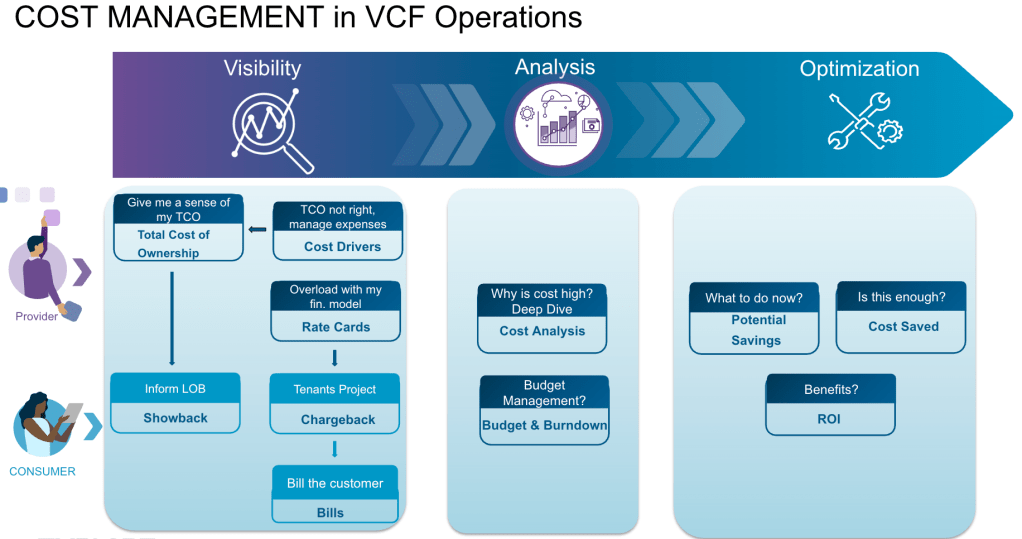
Delivered through a single pane of glass, VCF enables cost visibility, analysis, budgeting, optimization, and ROI insights while enabling showback for transparency and chargeback with customizable billing models—empowering enterprises to manage expenses, ensure accountability, and compare costs against public cloud efficiently.
Cloud Service Providers and FinOps
VMware Cloud Foundation (VCF) brings robust chargeback capabilities that cater to the unique needs of both enterprises and cloud service providers. For enterprises, VCF enables internal IT teams to bill back projects and application groups based on the resources they consume, creating financial accountability and promoting efficient usage. On the other hand, cloud service providers can leverage the same framework to track, meter, and charge tenants for the services delivered, ensuring fairness and transparency. By combining metering with data- and logic-backed billing, VCF empowers providers to generate accurate, itemized bills while giving consumers confidence that they are only paying for what they use.
Visibility
VCF Operations offers deep visibility into infrastructure layers: compute, storage, network, licenses, and support costs. TCO calculations include CapEx and OpEx along with hidden expenses such as facilities, maintenance and labor.
Total Cost of Ownership
VCF Operations Cost Overview (TCO) reveals the full financial impact of infrastructure, covering hardware, software, support, and overhead—helping providers assess profitability and IT teams make strategic capacity and modernization decisions.
Cost Overview (Total Cost of Ownership) answers the question “What is my overall cloud cost?“
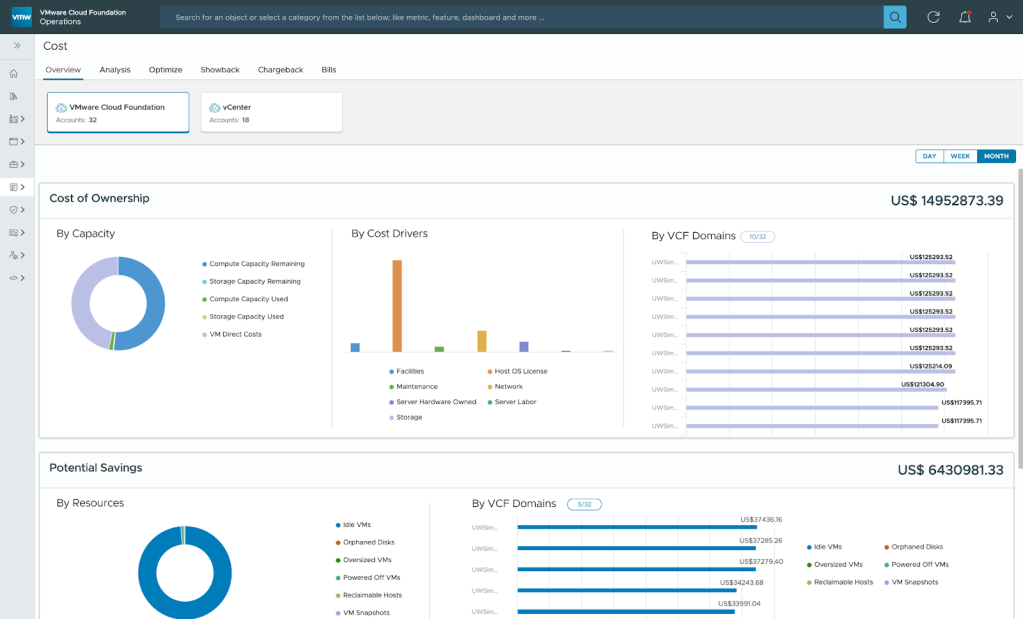
Total Cost of Ownership (TCO) or Cost Overview encompasses all costs related to owning and operating cloud infrastructure throughout its lifecycle. TCO covers direct cloud service costs like hardware, software license, Guest OS and indirect expenses like labor, facilities, maintenance.
Cost Drivers
FinOps in VCF highlights the primary drivers of cloud infrastructure costs. These include core infrastructure like compute, storage, and networking; software licensing for VMware and third-party tools; datacenter operational overhead such as energy consumption; and ongoing support and maintenance contracts.
Cost Drivers (Expense Management) answers the question “Why does my Total Cost seem off?”
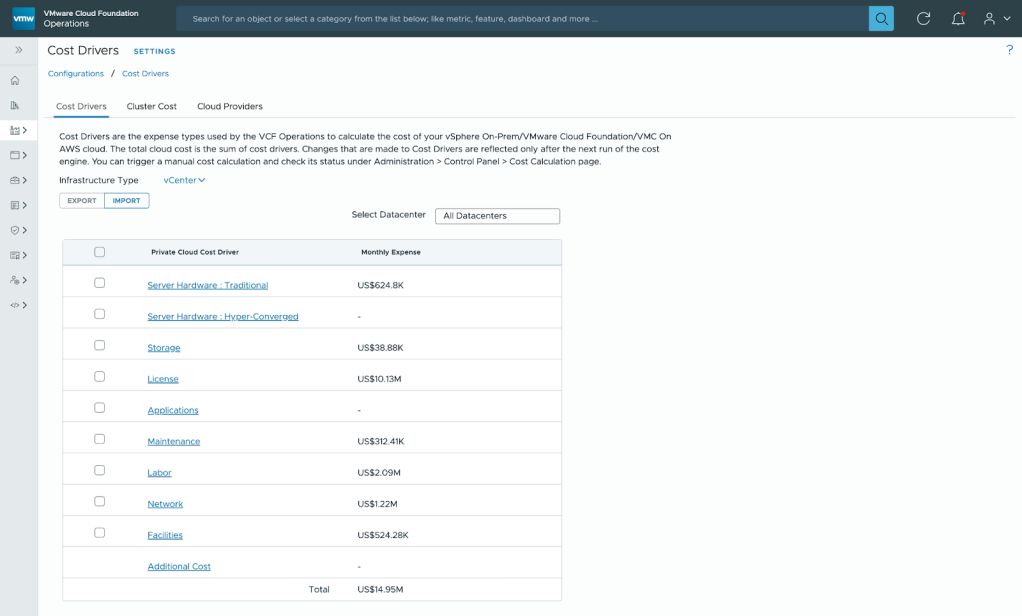
Cost drivers are your bulk of expenses managed on a single page and VCF Operations gives you a head start using the market standards. These include Hardware expenses (like servers) , software expenses (like licenses, OS etc) and all indirect expenses like labor, maintenance and facilities like power and cooling etc.
Rate Cards
Providers use rate cards to standardize resource costs (CPU, memory, storage). Flexible models ensure fairness for chargeback and billing, with VCF collecting usage data via adapters for accurate pricing at organizational and regional levels.
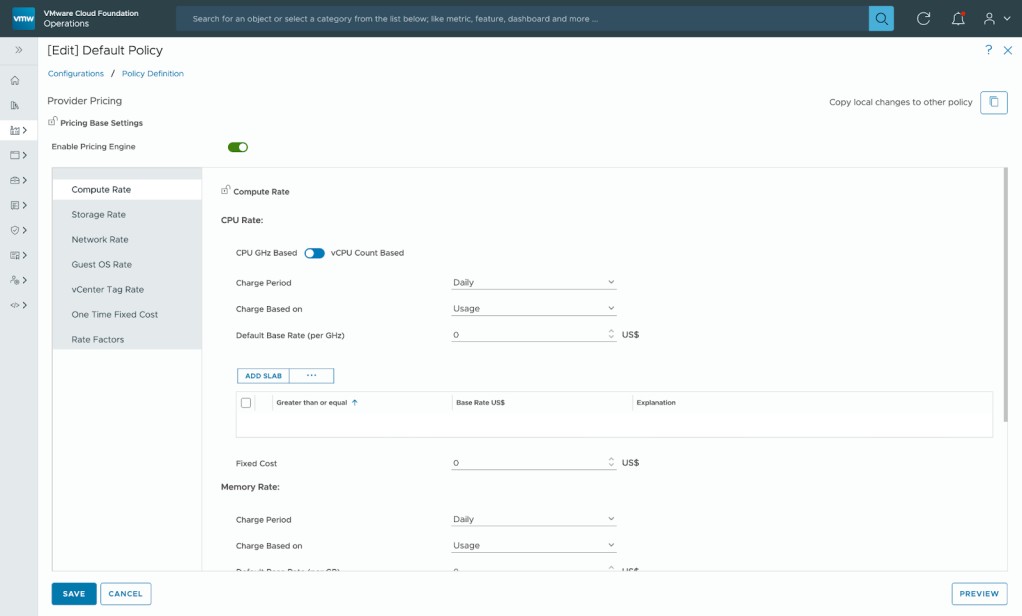
The Pricing Policy capability streamlines billing by letting providers create and manage rate cards with intuitive interfaces, ensuring precise, customizable pricing aligned to tenant and organizational needs.
Analysis
Cost Analysis
Cost Analysis helps you deep dive into your IT expenses and point out the problem areas or optimization opportunities through comparison and ranking capabilities.
Cost Analysis answers the question “Why is the cost high and where is it coming from?”
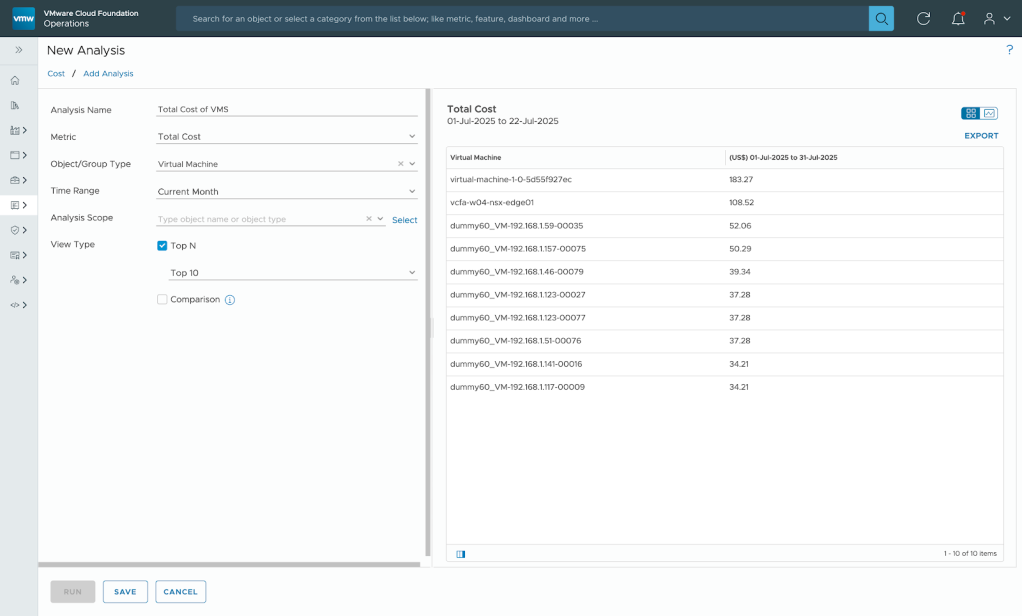
Cost analysis is a methodical process for organizations to examine and compare cost, price, and cloud bill metrics across objects, groups, applications, and tenants. Utilizing cost analysis, organizations gain insights into cloud spending, pinpoint inefficiencies, and make informed decisions to optimize cloud investments.
Budget Management
In VCF Operations, dashboards let teams set budgets, track spending, and configure 80–100% alerts. Burndown tracking prevents overspending and enforces accountability across projects and business units.
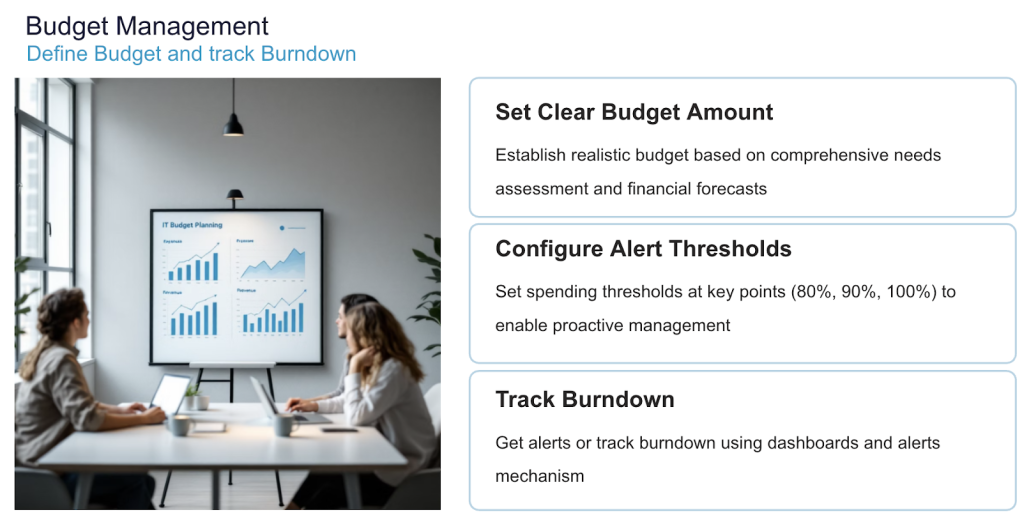
Optimization
VCF Operations Cost Optimization and Savings
Cloud cost optimization reduces expenses by rightsizing, reclaiming idle resources, and optimizing workloads. VCF highlights potential savings, quantifies costs, and guides informed financial decisions for ongoing efficiency.
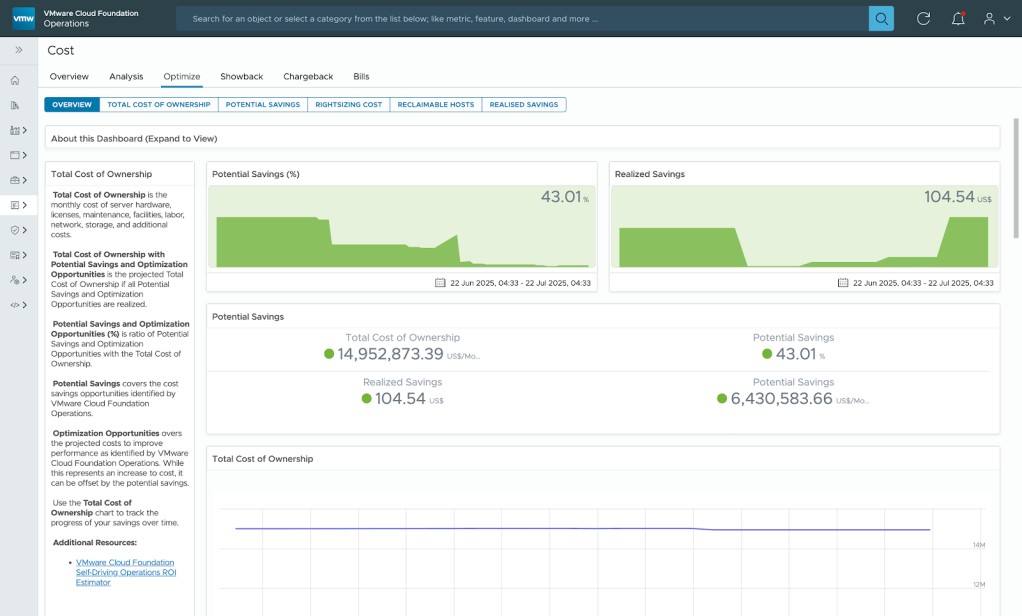
Potential Savings capabilities in VCF identify cost-reduction opportunities such as reclaiming unused VMs, snapshots, or oversized resources, and migrating workloads to more efficient infrastructure. These savings are quantified by showing the associated costs, enabling informed financial decisions.
Realized Savings capabilities include measuring savings achieved or costs avoided through applied recommendations, and reporting reclaimed capacity or allocation adjustments from previously oversized resources.
Return on Investment
VMware Cloud Foundation (VCF) delivers tangible returns by unifying compute, storage, networking, and security into a single integrated platform. By consolidating infrastructure, organizations can significantly reduce capital expenditures (CapEx) compared to traditional siloed systems, while also simplifying operations.
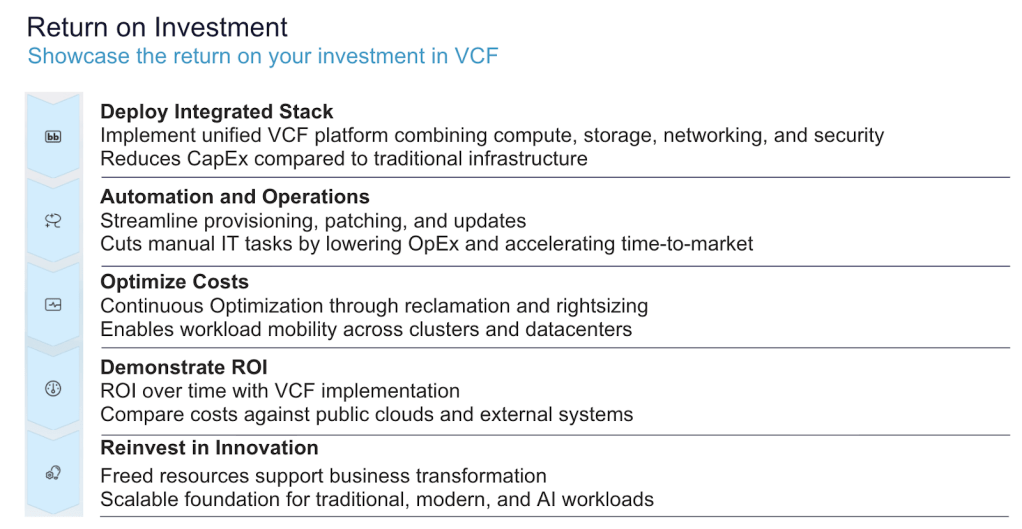
A major benefit of VCF lies in VCF Automation and VCF Operations. Routine tasks such as provisioning, patching, and updates are streamlined, cutting down manual IT effort, lowering operational expenditures (OpEx), and accelerating time-to-market for business-critical applications.
Equally important is the ability to optimize costs through continuous rightsizing and reclamation of resources.
Over time, these efficiencies allow businesses to demonstrate ROI clearly. Organizations can track the return on their VCF investments by comparing costs against public clouds and external systems, proving the platform’s long-term financial value.
Perhaps most strategically, VCF enables enterprises to reinvest in innovation. Freed-up resources and optimized budgets can be channeled into transformative projects, AI initiatives, and modern workloads, creating a scalable foundation for future growth and competitive advantage.
Consumer Side FinOps
Consumer-side FinOps capabilities in VCF empower developers and consumers to track, optimize, and govern IT service consumption directly through VCF Automation or through dashboards and content in VCF Operations.
Enterprise Consumer
Consumers (e.g., business units, departments) gain transparency into their IT consumption, making them accountable for their usage and costs.
Showback
Showback in VCF reports resource usage and costs without billing, helping business units understand IT consumption, drive accountability, and encourage responsible usage.
Cost Showback answers the question “How can I inform my LOBs and drive behavior?”
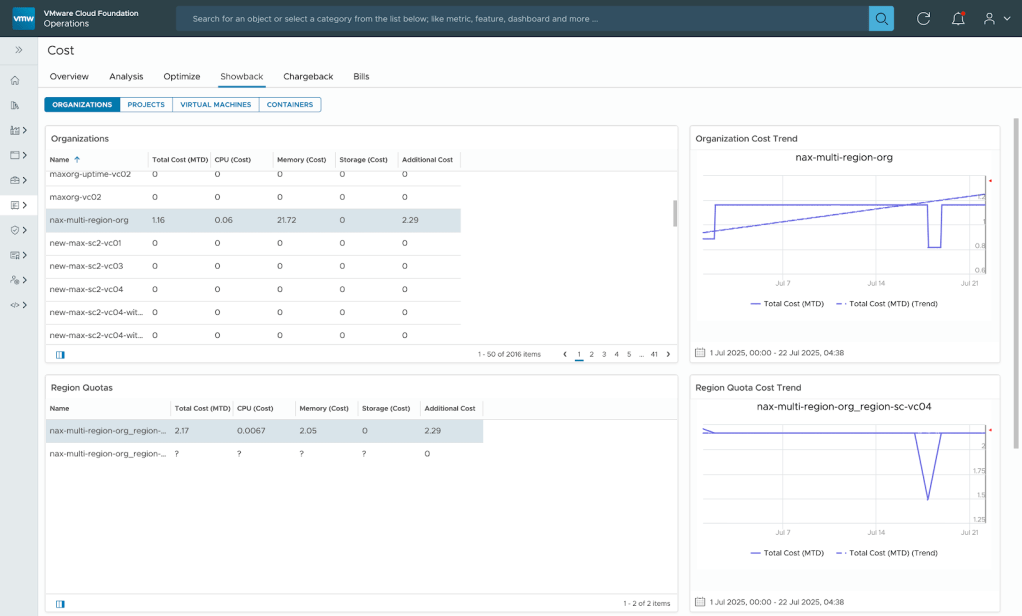
Showback capabilities in VCF Operations allow IT admins to view, analyze, compare, and bill back or showback costs per user, VM, project, organization, etc. This approach increases internal customers’ awareness of IT resource value and encourages efficient usage
Chargeback
Chargeback in VCF bills tenants or business units by actual consumption, supporting flexible models. Itemized bills ensure transparency, audits, accountability, and fair alignment of IT spending with business goals.
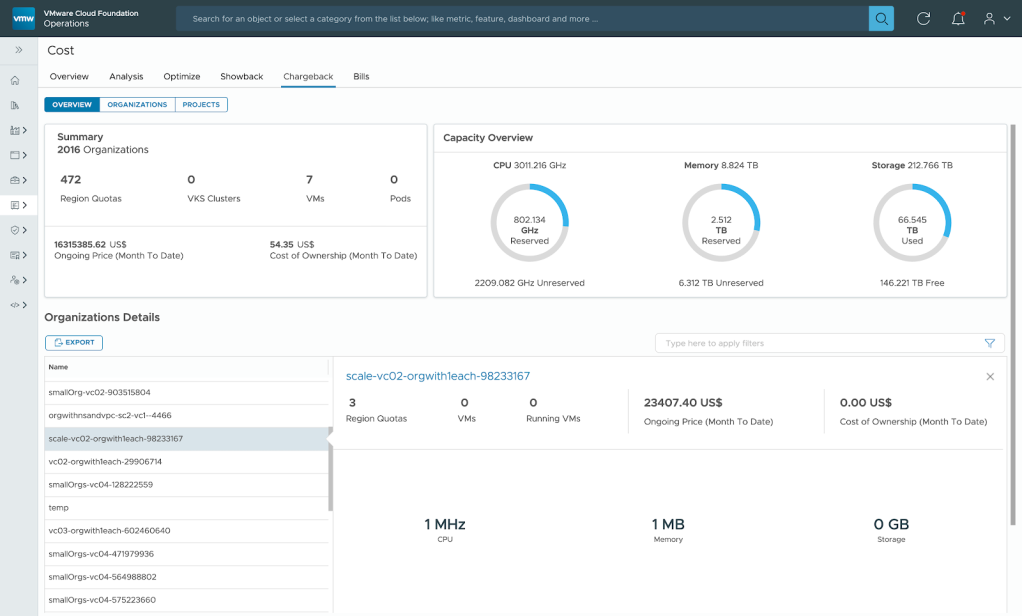
Chargeback capabilities help service providers and enterprises track tenant costs under IaaS, offering detailed breakdowns for financial management. Dashboards at organization, project, and namespace levels provide granular visibility into pricing structures and incurred costs.
Tenants
Tenants in VCF environments include multiple business units, departments, or external consumers, each billed or reported based on defined cost allocation models.
Chargeback
VCF supports multi-tenancy via VCFA, giving tenants detailed, chargeback-based bills that clarify spending, improve transparency, and help optimize workloads and financial decisions.
Bills
Bills provide detailed breakdown of charges by resource and usage, giving consumers clarity and enabling dispute resolution or optimization decisions.
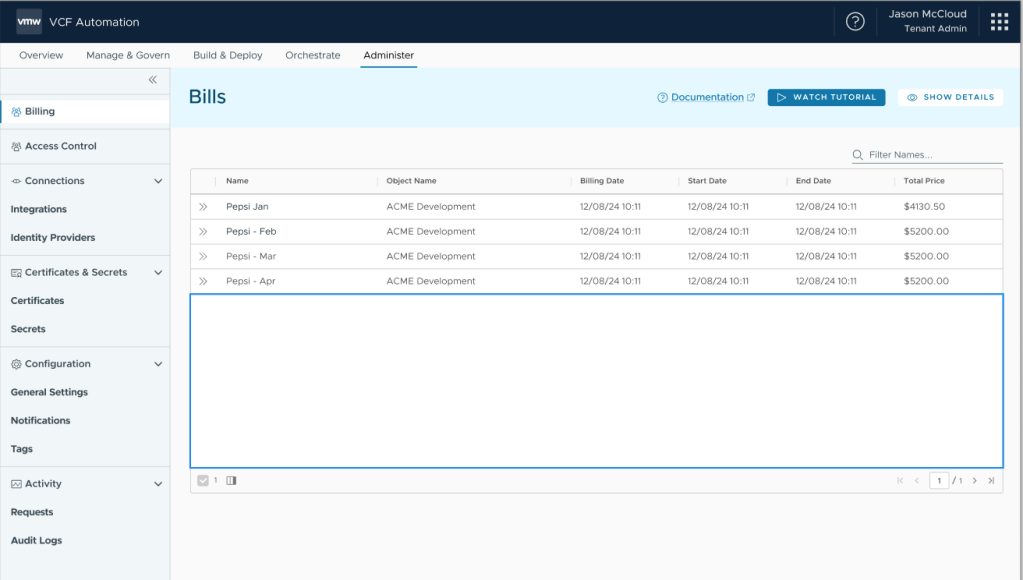
VCF billing streamlines financial management with automated, error-free bill generation and scheduling. Tenants access itemized monthly bills in VCFA, showing projects, charges, and periods to track usage and costs effectively.
Cost Planning
Consumers can estimate the cost of workloads before deployment. What-if modeling helps forecast impact of scaling workloads.
Workload Planning
Workload Planning answers the question “We are hiring new employees, how much would a suitable VM cost and will it fit my cluster?” or “Some of our team members are leaving, how much cost and capacity addition can I avoid on removal of their VMs?”
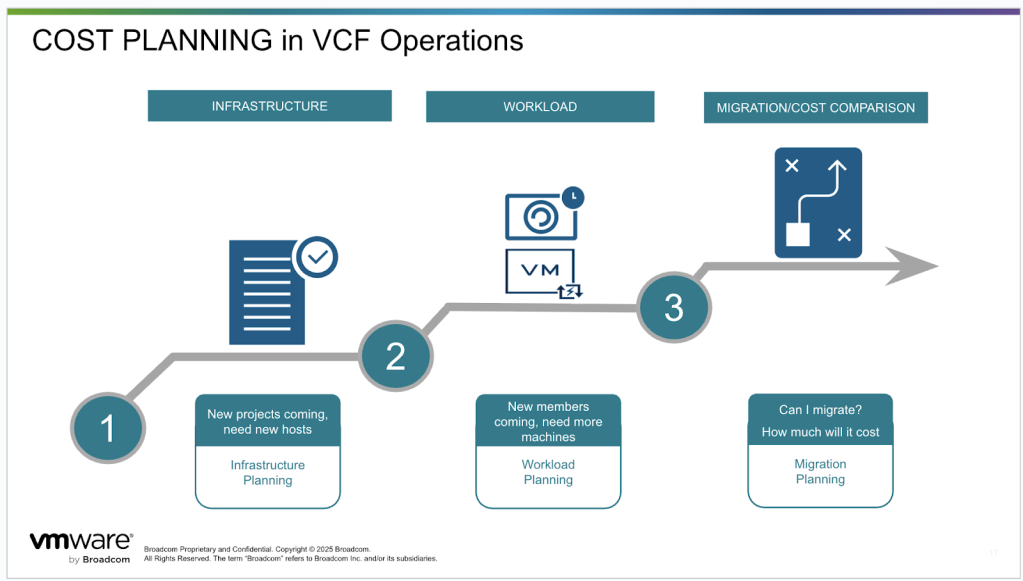
Workload Planning in VCF Operations assists with workload placement using performance, capacity, and cost analysis, with predictive scenarios to forecast needs for new or expanded workloads.
Infrastructure Planning
Infrastructure Planning answers the question “We are starting new projects, how much would a suitable host cost and will it fit my datacenter?” or “We are ending a project, how much cost and capacity addition can I avoid on removal of a host from my datacenter?”
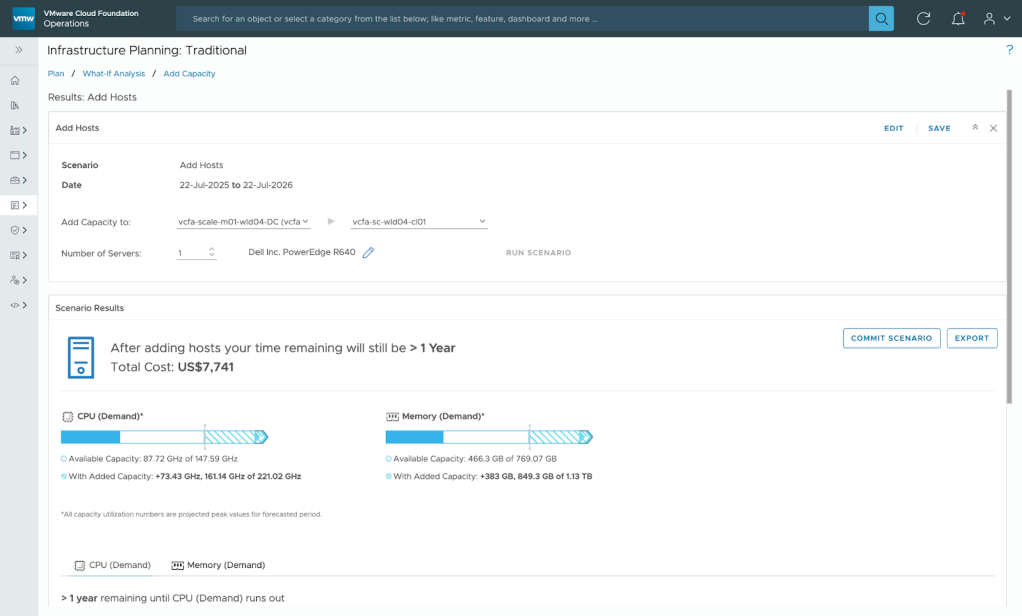
VCF Operations enables smarter infrastructure planning by forecasting costs with predictive scenarios, aligning growth to demand and supporting cost-efficient capacity decisions.
Cost Comparison/Migration Planning
Migration Planning answers the question “I have learnt about a new cloud type and want to see how much it will cost compared to my current cloud and others in the market?”
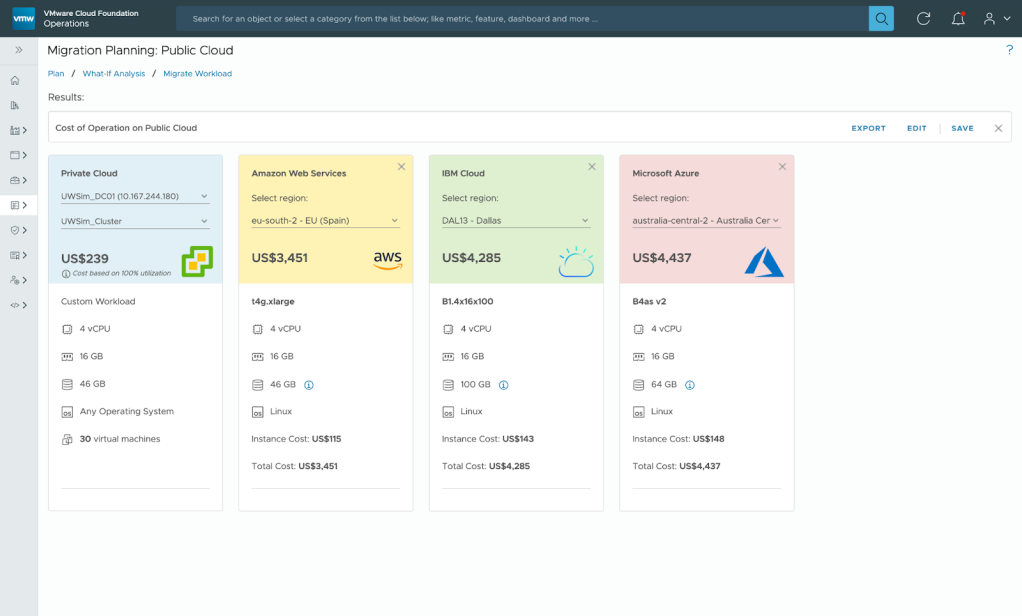
VCF Operations enables enterprises to compare workload costs across VMware and public clouds, supporting migration planning and smarter strategies through detailed cost analysis.
Takeaways
FinOps in VMware Cloud Foundation bridges the gap between technology and finance, giving both providers and consumers the insights and tools to optimize costs.
By embracing FinOps within VMware Cloud Foundation, organizations gain financial transparency, operational efficiency, and the flexibility to innovate with confidence. The combination of visibility, cost optimization, and accountability transforms cloud operations into a strategic advantage—ensuring every investment delivers measurable value for both business and technology outcomes.
Discover more from VMware Cloud Foundation (VCF) Blog
Subscribe to get the latest posts sent to your email.





